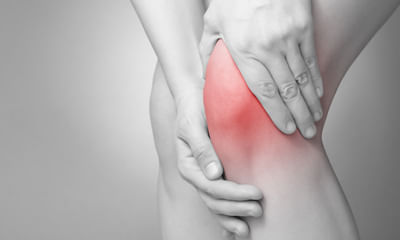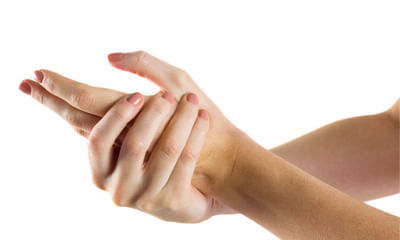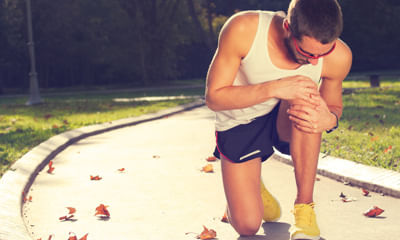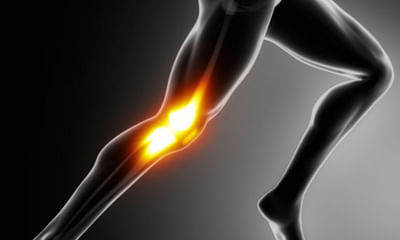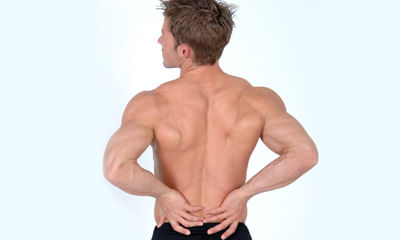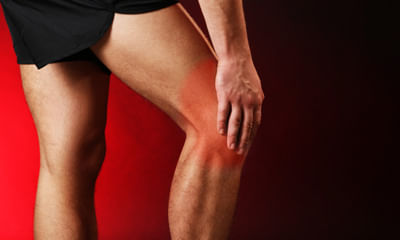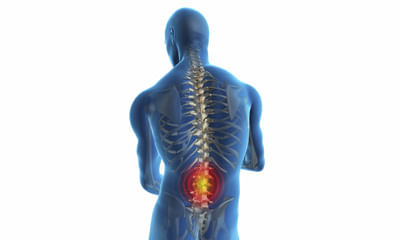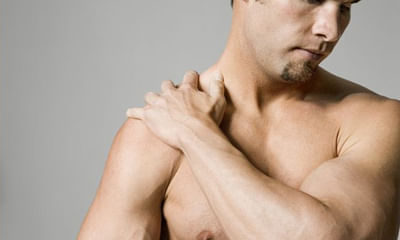Muscle Pain Relief Cream
I am 42 years old .now days I am getting some knee pain when I am sitting down or standing up, some time it pain and som ...
Ask Free Question
We do not prescribe medicines as we are physiotherapists if you want we can give you suggestions to address your knee pain. Knee pain this is a general knee pain and for this you can follow these measures: one keep a pillow right under the knee while sleeping, next is you can keep ice in the painful area for about 5--10 minutes, it looks like you are is important to check that. Anaemia always leads to the symptoms of being tired and also having body pain though there may not be any pathological reasons for knee pain. With knee exercises you will definitely feel better and muscles must be strengthened .•don't play through pain. As soon as you notice exercise-related knee pain, ice the area and rest. Until your knee is pain-free, avoid activities that put stress on your patellar tendon. •strengthen your muscles. Strong thigh muscles are better able to handle the stresses that can cause patellar tendinitis. Eccentric exercises, which involve lowering your leg very slowly after extending your knee, are particularly helpful. •improve your technique. To be sure you're using your body correctly, consider taking lessons or getting professional instructions when starting a new sport or using exercise equipment. •therapy •a variety of physical therapy techniques can help reduce the symptoms associated with patellar tendinitis, includingback pain it looks like you are anaemic. If you have back pain after you sit for long hours then it is due to your haemoglobin levels as it is important to check that. Anaemia always leads to the symptoms of being tired and also having back / leg pain though there may not be any pathological reasons for back pain. It looks like you are anaemic. And also you have to check with your vitamin and calcium, if the bones are weak then automatically the pain gets triggered more as there is less severity of the painbe strengthened 1.resisted terminal knee extension: make a loop with a piece of elastic tubing by tying a knot in both ends. Close the knot in a door at knee height. Step into the loop with your injured leg so the tubing is around the back of your knee. Lift the other foot off the ground and hold onto a chair for balance, if needed. Bend the knee with tubing about 45 degrees. Slowly straighten your leg, keeping your thigh muscle tight as you do this. Repeat 15 times. Do 2 sets of 15. If you need an easier way to do this, stand on both legs for better support while you do the exercise. 2•standing calf stretch: stand facing a wall with your hands on the wall at about eye level. Keep as arthritis is very common that you get generally bilaterally. Ice therapy would definitely help to reduce the inflammation. We also advise you to use knee cap which would help to prevent the knee from damaging further and also to maintain the quadriceps muscle tone •stretching exercises. Regular, steady stretching exercises can reduce muscle spasm and help lengthen the muscle-tendon unit. Don't bounce during your stretch. 3•strengthening exercises. Weak thigh muscles contribute to the strain on your patellar tendon. Exercises that involve lowering your leg very slowly after extending it can be particularly helpful, as can exercises that strengthen all of the leg muscles in combination, such as a leg press.•this is a general knee pain and for this you can follow these measures: one keep a pillow right under the knee while sleeping, next is you can keep ice in the painful area for about 5--10 minutes, it looks like you are is important to check that. Anaemia always leads to the symptoms of being tired and also having body pain though there may not be any pathological reasons for knee pain. With knee exercises you will definitely feel better and muscles must be strengthened.
I am 50 year old woman I have a heel pain can you please suggest me a well medicine for this doctor. Thank you. ...
Ask Free Question
Here are some non-medication treatments commonly recommended for heel pain: rest: avoid activities that aggravate the pain and give your heels time to rest and heal. Ice: apply ice packs to the affected area for about 15-20 minutes several times a day to reduce inflammation and relieve pain. Stretching exercises: perform gentle stretching exercises for the calf muscles and plantar fascia to improve flexibility and reduce tension in the heel area. Footwear: wear supportive shoes with good arch support and cushioning to reduce strain on the heels. Avoid flat shoes or high heels that may exacerbate heel pain. Orthotic inserts: consider using orthotic inserts or heel cups to provide additional support and cushioning for your heels. Night splints: use night splints while sleeping to keep the foot in a neutral position and stretch the plantar fascia and achilles tendon. Physical therapy: a physical therapist can provide specialized exercises and treatments to alleviate heel pain and improve foot mechanics. Weight management: maintain a healthy weight to reduce pressure on the heels and minimize strain on the feet. Avoid barefoot walking: avoid walking barefoot, especially on hard surfaces, to prevent further irritation to the heels. If conservative treatments do not provide relief, your healthcare provider may recommend other interventions such as corticosteroid injections, shockwave therapy, or surgery in severe cases.
Mam me 29 saal ki ek female hun married hun mera naam snehalata hai mam mujhe viginal fungal infaction hua hai aur maine ...
Ask Free Question
Hi, Lybrate user, •wear ,loose under garments to allow fresh air to pass through, nourishing your pelvic, groin and vaginal muscles to check infection.•clean external and internal genital area with underlying homoeopathic medicine. @ echinecea q -20 drops with 1/2 cup of water, apply ,thrice, daily, deep into vagina and vulva, gently. •@take, 10 drops of echineceaq -mixed with 2tsfl of water, thrice, orally. •consult ,privetly for a better and faster recovery, please. •avoid, junk food, alcohol and nicotine. •report after a wk, privetly, please. Tk, care.
I take 50 kg weight on my hands after that my both shoulders getting pain too much it's been 2 month ago then I go to do ...
Ask Free Question
It's important to address your concerns about the pain in your shoulders and overall weakness, especially since you work in a physically demanding environment and are experiencing discomfort. Here are some steps you can take: follow up with your doctor: since you experienced relief from pain after taking the prescribed medication but are now experiencing pain again, it's essential to follow up with your doctor for further evaluation. They can reassess your condition, determine if there are any underlying issues contributing to your symptoms, and adjust your treatment plan accordingly. Rest and recovery: allow your shoulders to rest and avoid activities that exacerbate the pain. Avoid lifting heavy objects or putting excessive strain on your shoulders until you've had a chance to consult with your doctor and address the underlying cause of your pain. Maintain good posture: pay attention to your posture, both at work and during other activities. Poor posture can contribute to shoulder pain and muscle fatigue. Be mindful of how you sit, stand, and move throughout the day, and make adjustments as needed to maintain proper alignment and reduce strain on your shoulders. Exercise and stretching: gentle stretching and strengthening exercises for the shoulders and upper body muscles can help improve flexibility and alleviate muscle tension. However, it's essential to consult with a healthcare professional or physical therapist before starting any new exercise program to ensure it's safe and appropriate for your condition. Healthy lifestyle habits: pay attention to your overall health and lifestyle habits. Eating a balanced diet, staying hydrated, getting regular exercise, and prioritizing rest and relaxation can all contribute to overall well-being and may help alleviate symptoms of fatigue and weakness. Environmental factors: consider how environmental factors such as air conditioning and diet may be impacting your health. Ensure that you're staying hydrated, especially in a hot climate like dubai, and consider incorporating more nutritious foods into your diet to support overall health and energy levels. Seek support: don't hesitate to seek support from your healthcare provider, colleagues, friends, or family members if you're feeling worried or overwhelmed. It's important to address your concerns and prioritize your health and well-being.
My mother is 56 years old. She has been suffering with knee joints pain from last 9 years. Doctor says for knee replacem ...
Ask Free Question
Diabetes and knee replacement: diabetes can increase the risk of complications during surgery, including knee replacement surgery. However, many people with well-controlled diabetes can undergo knee replacement surgery safely. It's essential for your mother to discuss her diabetes management with her healthcare provider and the orthopedic surgeon who will perform the knee replacement. They will assess her overall health and determine if she is a suitable candidate for surgery. Close monitoring of blood sugar levels before and after surgery will be important to minimize the risk of complications. Numbness in feet: numbness and tingling in the feet can be symptoms of diabetic neuropathy, a common complication of diabetes that affects the nerves. It's important for your mother to have a thorough evaluation by a healthcare provider to assess her symptoms and determine the underlying cause. Additional tests, such as nerve conduction studies or electromyography (emg), may be recommended to evaluate nerve function. Shoulder, arms, and legs pain: pain in the shoulders, arms, and legs can have various causes, including arthritis, nerve compression, muscle strain, or other musculoskeletal conditions. Your mother may benefit from a comprehensive evaluation by a healthcare provider, possibly including imaging studies such as x-rays or mri, to determine the cause of her pain and develop an appropriate treatment plan. Comprehensive check-up: to address your mother's multiple symptoms and concerns, it's important for her to undergo a comprehensive medical evaluation. This may include: blood tests: to assess blood sugar levels, kidney function, lipid levels, and other metabolic parameters. Nerve function tests: to evaluate for diabetic neuropathy or other nerve-related issues. Imaging studies: such as x-rays, mri, or ultrasound to assess the condition of the knee joints, shoulders, and other affected areas. Consultations with specialists: such as an orthopedic surgeon, endocrinologist (for diabetes management), or neurologist (for nerve-related issues). Holistic approach: given your mother's multiple symptoms and medical conditions, a holistic approach to her care may be beneficial. This could include optimizing diabetes management, incorporating physical therapy or exercise programs to improve mobility and strength, and exploring options for pain management and symptom relief.
My knees and hip bones pain, and I feel incredibly lethargic. I also struggle with constipation. I'm unable to gain weig ...
Ask Free Question
It's essential to address your multiple symptoms comprehensively, as they may indicate underlying health issues that need attention. Here are some steps you can take to address your concerns: consult with a healthcare professional: schedule an appointment with a healthcare provider, such as a primary care physician or internist, to discuss your symptoms. They can conduct a thorough evaluation, review your medical history, and perform necessary tests to determine the underlying cause of your knee and hip pain, lethargy, constipation, and difficulty gaining weight. Physical examination: your healthcare provider will perform a physical examination to assess your overall health, including your joints, muscles, and gastrointestinal system. They may also check your vital signs and conduct a neurological examination to evaluate any potential issues. Diagnostic tests: based on your symptoms and physical examination findings, your healthcare provider may recommend various diagnostic tests, including blood tests to assess for inflammatory markers, nutritional deficiencies, thyroid function, and other potential underlying conditions. Imaging studies such as x-rays or mri may also be ordered to evaluate your knee and hip joints if necessary. Treatment plan: once a diagnosis is established, your healthcare provider will work with you to develop a personalized treatment plan tailored to your specific needs. This may include medication management for pain relief or underlying conditions, dietary modifications to address constipation and support weight gain, physical therapy to improve joint mobility and strength, and lifestyle changes to improve overall health and well-being. Nutrition and lifestyle: pay attention to your diet and lifestyle habits, as they can significantly impact your symptoms. Focus on consuming a balanced diet rich in fruits, vegetables, whole grains, lean proteins, and healthy fats to support overall health and provide essential nutrients. Stay hydrated and incorporate regular physical activity into your routine to improve energy levels and promote overall well-being. Manage stress: stress can exacerbate symptoms such as lethargy and constipation. Practice stress-reduction techniques such as mindfulness meditation, deep breathing exercises, yoga, or spending time in nature to help manage stress and improve overall relaxation. Follow-up: be sure to follow up with your healthcare provider regularly to monitor your progress, adjust your treatment plan as needed, and address any new or worsening symptoms.
Having sudden pain today at my lower back (exactly behind waist area). Maybe due to bone dislocation or something. Not a ...
Ask Free Question
May be due to lower back muscle spasm. Do heat therapy and take analgesics. Avoid lifting weight for some time.
Sir I am 27 year old male I have symptoms of left shoulder and wrist pain while walking so I went to doctor doctor do fo ...
Ask Free Question
It looks like cervical pain that's the reason you have pain in the shoulder and along side until wrist. You need to take rest and you need to consult physiotherapist you need to do intermittent cervical traction and also inferential therapy treatment which will help you to get subsided with pain. Neck pain cervical spondylosis– chronic condition with radiating pain this is cervical pain (neck pain) and that's the reason the pain radiates until the shoulder blades. If you keep ice that would help and along side you can do hot water fermentation. You shall use cervical collar which would help you to reduce the radiating pain ie. Due to the nerve compression. You have to go for traction and also you can do ift. Please consult the near bytherapist for quick relief. Use collar will definitely be helpful for him to maintain the good posture. And also cervical pillow can be used which might make you to have better posture of the shoulder neck and arm. Neck tilt: from the sitting position, tilt your head down so your chin touches your chest. Hold this position for 5 second s. Return to the starting position and repeat. Do this five times. Side-to-side neck tilt. From the same starting position, tilt you neck toward one shoulder, leading with your ear. Hold for 5 seconds and then return to the starting position. Do this five times on each side. Neck turn. Look straight ahead, then turn your head to one side, keeping your chin at the same level. Do this five times on each side. Neck stretch. Holding the rest of your body straight, push your chin forward, stretching your throat. Hold for 5 seconds. From the same starting position, push your chin backward and hold for 5 seconds. Do the forward and backward stretch five times each. If any of these exercises cause severe pain or weakness in your hands or arms, stop right away and talk with your doctor. We suggest you to wear cervical collar which will help you to improve the cervical angle and also it definitely helps you to improve the neck posture due to which your neck pain is triggered more. The importance of wearing cervical collar is to give good stability to the neck and also it definitely prevents you to have excess neck movements which makes the condition worse. If you wear cervical collar you cannot turn your neck as you like which itself will help you to have better functioning of the cervical spine. This cervical soft collar what we are suggesting for you is available at our clinic. If you want you can buy from us, if you are far away from chennai we can send you by courier. The reason why we are conveying you to buy from us is we can demonstrate over the videocall (using whatsapp) and also we can monitor you throughout when to wear it and how long to wear it. And also if you find any difficulty wearing the brace you can also revert back to us for few more suggestions and we can propose you good solution how to go about it. Pushups this one may seem basic, but there’s no denying that pushups are one of the best ways to strengthen the pectoral muscles. These can be done on the knees or toes. If you’re not ready for full pushups, start with your hands resting on a solid surface higher than your feet — like a very sturdy coffee table or the edge of a couch, cushions removed, that’s pressed up against a wall — and start on the toes. Having your hands higher than your feet and your body at an angle can be a good way to start a pushup regimen. As you get stronger, you can begin to lower the angle of your body. This will help you transition to full pushups more easily than going from knees to toes. A full plank engages the muscles differently, even at an angle. When doing pushups, aim for 2 sets of 10 reps per day. 1.start in plank position with your hands under your shoulders and your core engaged. 2.as you lower, inhale. 3.as you engage your muscles to push yourself up, exhale. Keep your elbows hugging in close to your body. Keep your focus on slowly breathing as you do these, and on engaging the pectorals while keeping the core tight. Don’t just crank these out to get them done — this can compromise your form and do more harm than good. If the movement is really tough, break the sets into three or five to start, or find a higher point to begin after a week of exercise. If necessary, you can even stand and do pushups pushing against a wall. Chest fly for this exercise, you’ll need a bench or exercise ball as well as some dumbbells. If you don’t have weights, you can always use the old standby: a soup can in each hand. Just keep in mind that dumbbells are easier to hold and you can get more out of using them, as even 5-pound weights are heavier than your heaviest canned goods. 1.lie with your upper and middle back on a bench or ball, with your legs at a 90-degree angle. Hold a weight in each hand and extend your arms to the sky, elbows slightly bent. 2.as you inhale, lower your arms out wide, until your elbows are at shoulder height. 3.as you exhale, raise your hands until they meet above your chest again. 4.do 2 sets of 10. If that feels pretty easy, up it to 2 sets of 15 or increase the weight you’re using. Dumbbell row strengthening your back muscles is an important component of treating pectusexcavatum. The dumbbell row targets your lat muscles. The way it’s described below also strengthens your core, another important component of treating the condition. You’ll need some dumbbells to complete this move — err on the lighter side if you’ve never done a row before. 1.hold one dumbbell in each hand with your arms extended. Hinge at the hips until your upper body reaches a 45-degree angle. 2.keeping your neck in line with your spine and your gaze straight down, pull your elbows straight back and squeeze between your shoulder blades. 3.extend your arms back to the starting position. Complete 2 sets of 10. Dumbbell rear delt fly another move to strengthen your back, a dumbbell rear delt fly also focuses on the lats, as well as the rhomboids and the traps. Choose a light pair of dumbbells to complete this move and ensure that you’re pinching your shoulder blades together at the top to get the most out of it. 1.hold one dumbbell in each hand with your arms extended. Hinge at the hips until your upper body reaches a 45-degree angle and bring the dumbbells together. 2.keeping your spine and neck neutral, inhale and push the dumbbells out and up to the side until your arms are parallel to the floor. 3.exhale and return to the start in a slow and controlled motion. Complete 2 sets of 10. Exercise is a key component to treating pectusexcavatum. By strengthening your chest, back, and core muscles and stretching your chest cavity, you can combat the condition’s effects. Aim to complete these exercises several times a week to maximize results. Anterior pelvic tilt 1.lie on the back with the knees bent and feet flat on the floor, hip-width apart. 2.squeeze the buttocks and tilt the pelvis upward. 3.the back should feel as though it is flattening to the ground. 4.return to normal pelvis position. 5.repeat 10–12 times.
I have l4l5 l5s1 disc problem. I have pain in my back when I sit down and not stand for some time. I can't walk properly ...
Ask Free Question
That is called as lumbar vertebrae. And there are 5 lumbar vertebrae and the 5th lumbar vertebrae is always is located in the lower end where the body weight is taken and it is generally fused with sacral vertebrae. That is where the sciatic nerve passes by and the nerve gets compressed that's the reason you have pain and sensation is disturbed. Loss of concavity of l4-l5 vertebrae. It is other wise called as the lumbo sacral curve which is very important for the spine to take the entire weight evenly if not it leads to disturbance of the disc and also the vertebrae which makes the spine to loose its concavity that's why it is called as loss of posterior concavity. For which we need to improve the spine posture and we need to adapt good posture during our day to day life activities.
I am 45 years old height 5'8" weight about 81 kg. Am having frozen shoulder in right shoulder. Can anti inflammatory inj ...
Ask Free Question
Do’s and don’ts for shoulder pain do’s do the prescribed exercise regularly to maintain strength, flexibility and range of motion. Do keep the affected arm supported. Use an ice pack for pain relief. Apply the ice pack 3-4 times a day for 10 minutes. Don’ts don't sleep on the affected side. Don't lift heavyweight with the affected arm. Don't jerk your shoulder to avoid stress. Don't use the arm to push yourself up in bed or from a chair. Don't participate in contact sports or do any repetitive heavy lifting. We suggest you to wear shoulder support brace which is available in two different sizes which makes the patient to feel comfortable as it maintains the shoulder in anatomical position and the short lever is maintained. The reason to maintain the short lever in the shoulder joint is it helps the shoulder to prevent the movements which itself is the key to have better progression of healing in the shoulder region. This is suggested for the following conditions. This shoulder support brace what we are suggesting for you is available at our clinic. If you want you can buy from us, if you are far away from chennai we can send you by courier. The reason why we are conveying you to buy from us is we can demonstrate over the videocall (using whatsapp) and also we can monitor you throughout when to wear it and how long to wear it. And also if you find any difficulty wearing the brace you can also revert back to us for few more suggestions and we can propose you good solution how to go about it. Strenghtening exercises 1.pendulum stretch do this exercise first. Relax your shoulders. Stand and lean over slightly, allowing the affected arm to hang down. Swing the arm in a small circle — about a foot in diameter. Perform 10 revolutions in each direction, once a day. As your symptoms improve, increase the diameter of your swing, but never force it. When you're ready for more, increase the stretch by holding a light weight (three to five pounds) in the swinging arm. 2. Towel stretch hold one end of a three-foot-long towel behind your back and grab the opposite end with your other hand. Hold the towel in a horizontal position. Use your good arm to pull the affected arm upward to stretch it. You can also do an advanced version of this exercise with the towel draped over your good shoulder. Hold the bottom of the towel with the affected arm and pull it toward the lower back with the unaffected arm. Do this 10 to 20 times a day. 3. Finger walk face a wall three-quarters of an arm's length away. Reach out and touch the wall at waist level with the fingertips of the affected arm. With your elbow slightly bent, slowly walk your fingers up the wall, spider-like, until you've raised your arm as far as you comfortably can. Your fingers should be doing the work, not your shoulder muscles. Slowly lower the arm (with the help of the good arm, if necessary) and repeat. Perform this exercise 10 to 20 times a day. 4. Cross-body reachsit or stand. Use your good arm to lift your affected arm at the elbow, and bring it up and across your body, exerting gentle pressure to stretch the shoulder. Hold the stretch for 15 to 20 seconds. Do this 10 to 20 times per day. 5. Armpit stretch using your good arm, lift the affected arm onto a shelf about breast-high. Gently bend your knees, opening up the armpit. Deepen your knee bend slightly, gently stretching the armpit, and then straighten. With each knee bend, stretch a little further, but don't force it. Do this 10 to 20 times each day. Starting to strengthen as your range of motion improves, add rotator cuff–strengthening exercises. Be sure to warm up your shoulder and do your stretching exercises before you perform strengthening exercises. 6. Outward rotationhold a rubber exercise band between your hands with your elbows at a 90-degree angle close to your sides. Rotate the lower part of the affected arm outward two or three inches and hold for five seconds. Repeat 10 to 15 times, once a day. 7. Inward rotation stand next to a closed door, and hook one end of a rubber exercise band around the doorknob. Hold the other end with the hand of the affected arm, holding your elbow at a 90-degree angle. Pull the band toward your body two or three inches and hold for five seconds. Repeat 10 to 15 times, once a day. Shoulder exercises and stretches regular exercises and stretches can keep your shoulder strong and flexible. A few things to remember before swinging in to exercises: •stop any exercise if you have more shoulder pain. It may be too soon for you to try. •watch your form. Exercising incorrectly can also cause or worsen shoulder problems. •warm up, even before deep stretching. Light shoulder rolls, gentle movements, or even a warm shower are all ways to warm up your muscles before exercise and stretching. Pendulum stretch for range of motion•stand and bend at the waist. •let your arm on the injured side hang straight down. •keep your neck relaxed. •move your arm in a circle up to 20 times. •do once or more times in a day. Overhead shoulder stretch•sit or stand to do this shoulder stretch. •intertwine your fingers in front of you. •bend your elbows and raise your arms above your head. You can also place your hands on your head or behind it. •gently squeeze your shoulder blades together to move your elbows back. •continue for up to 20 repetitions. Repeat 5 to 10 times a day.Pa shoulder: do’s: •exercise regularly and immediately follow a physical therapy program. •use an ice pack for pain relief. Apply the ice pack 3-4 times a day for 10 minutes. •take pain relievers as directed by your shoulder doctor. Don’ts: •don’t stop moving your shoulders entirely because of the pain. •do not do activities that involve sudden movements, such as heavy lifting on the affected side. As your body recovers, continue to make gentle movements, but avoid irritating and moving your shoulders. •doesn’t sleep on a sore shoulder •don’t miss your workout routine and physical therapy. •don’t neglect your diet. Frozen shoulder is associated with general health. Frozen shoulder is strongly associated with many low-grade systemic inflammatory conditions. Your body needs healthy, anti-inflammatory food to recover. •stop smoking and drinking alcohol. No it will definitely help you to come out of pain. You can consume preferably one tablet per day and not more than that. Drink lot of hot water during your cycle time as there might be gastric trouble during menstrual cycle. We cannot give suggestions about homeopathy medicine as we are physiotherapists. I have given the following suggestions and protocols for your other pain in the back, heel and shoulder.

